In the last few years, technological development has sped up at an unprecedented level and has shown no sign of stopping any time soon. Of course, with the blazing speed of these developments, some old tech inevitably gets left behind. This seems to have been the fate of some scaling solutions in the layer-2 networks.
More: Bitcoin Rollups Face Sustainability Issues, Vitalik Offers Solutions
Ethereum co-founder Vitalik Buterin has proven himself to be a man of the future. He has said that he only plans to publicly mention layer-2 networks that are “stage 1” or higher. From his X announcement, he probably won’t pay much attention to networks of lower calibers. However, he mentioned that he may be allowing a “short grace period for new, genuinely interesting projects.”
I take this seriously. Starting next year, I plan to only publicly mention (in blogs, talks, etc) L2s that are stage 1+, with *maybe a short grace period* for new genuinely interesting projects.
— vitalik.eth (@VitalikButerin) September 12, 2024
It doesn't matter if I invested, or if you're my friend; stage 1 or bust.
Multiple… pic.twitter.com/4cGxgsfmUc
No matter how it sounds, Buterin seems not to be doing it to downplay the importance of the lesser L-2 networks. He mentioned that many zero knowledge rollup teams have told him that “they’re on track to be stage 1 by year-end”, and he was looking forward to seeing that happen.
Strengthening his stance, he wrote, “The era of rollups being glorified multi-sigs is coming to an end, and the era of cryptographic trust is upon us”.
In fairness @arbitrum has been leading the charge on actually meeting the stage 1 requirements!
— vitalik.eth (@VitalikButerin) September 11, 2024
This announcement might have sounded a little harsh, but in 2022, Buterin introduced the concept of “training wheels” for Ethereum scaling rollup projects at various stages of development.
Back in 2022, he outlined a three-staged path to Layer-2 decentralization.
His first stage is “stage 0” or “full training wheels”.It is described as a project that self-identifies as a rollup in which all rollup transactions are on-chain, and users can transact without operator intervention. The downside of this stage is that it involves only a simple multi-signature wallet in control, and no fraud or validity proofs are required.
The second one, “stage 1,” unlike the previous one, has an active fraud-proof or validity-proof scheme in place. It should have a multi-signature-based override mechanism, or “security council,” programmed with strict conditions such as a minimum of 6 of 8 signatures and a quorum-blocking group. All upgrades should have a seven-day delay window.
At the third and final stage, “stage 2” or “no training wheels,” no group can override the code output if the code is bug-free for projects. This last stage also involves a limited use of security councils allowed only for clear bug cases and a 30-day upgrade activation delay.
But even before Vitalik Buterin came forward with this announcement, many layer-2 rollup teams had already agreed to upgrade. In June 2024, L-2 rollup teams, including those for Linea, ZKsync, Arbitrum, and Optimism, all said that “stage 2” of full decentralization is in a few years.
Welcome @optimism to the club of stage 1+ L2s! (meaning, L2s where the proof systems actually have teeth) I'm looking forward to seeing many more L2s join this club soon, especially some ZK ones. pic.twitter.com/QTfXVoZo2t
— vitalik.eth (@VitalikButerin) June 11, 2024
More: What Is Behind Ethereum Layer-1 Network Revenue Collapse?
While Buterin doesn’t seem interested in waiting a few years for that to happen, he also mentioned that “we” should not throw away these “training wheels.” But even at that, time is ticking for these stage zero networks. The time has come to make that upgrade.

Disclaimer: All materials on this site are for informational purposes only. None of the material should be interpreted as investment advice. Please note that despite the nature of much of the material created and hosted on this website, HODL FM is not a financial reference resource and the opinions of authors and other contributors are their own and should not be taken as financial advice. If you require advice of this sort, HODL FM strongly recommends contacting a qualified industry professional.





